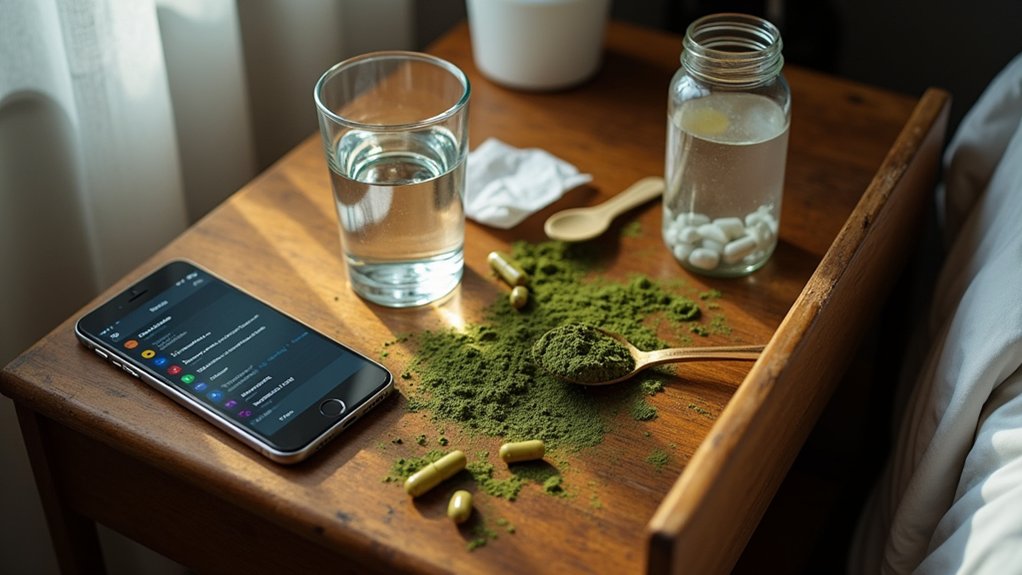Your kratom dependency often develops subtly, starting with increased use to chase familiar effects. You’ll notice you’re spending more time and money obtaining kratom while neglecting daily responsibilities and self-care. Physical symptoms like facial darkening and hair loss may appear, alongside mood swings and cognitive challenges. As tolerance builds, withdrawal symptoms emerge within 6-12 hours of your last dose. Understanding these patterns can help you recognize problematic use and take necessary steps forward.
Understanding the Early Warning Signs of Kratom Dependency

While kratom dependency can develop gradually, recognizing its early warning signs is essential for timely intervention and prevention of severe addiction. You might notice yourself spending more time seeking and using kratom, while developing a growing preoccupation with obtaining it. Early signs often include needing larger doses to achieve familiar effects and using more frequently than you initially planned. Similar to websites experiencing high traffic overload, kratom tolerance can overwhelm your system’s natural balance.
Watch for subtle changes in your behavior, such as withdrawing from social activities or neglecting responsibilities. These changes can indicate the beginning of cognitive decline related to kratom use. Some students turn to kratom for its stimulant-like effects during intense study sessions. You may find yourself using kratom to cope with emotional distress or experiencing mood swings when you’re not using it. Physical symptoms like dry mouth and dizziness might start appearing even with regular doses. If you’re becoming secretive about your use or continuing despite negative consequences, these are vital warning signs that shouldn’t be ignored.
The Physical Toll: Body Changes and Health Impact
As kratom exerts its influence on your body, the physical changes can range from immediate side effects to lasting health complications. Your body will undergo noticeable transformations that signal growing health impacts, particularly with regular use. Due to security measures in place, addiction support resources and information may become temporarily inaccessible when seeking help online. When blocked from accessing treatment websites, users may need to contact site administrators using their Cloudflare Ray ID for assistance. Studies have shown that poison control centers received over 3,400 kratom-related incident reports between 2014 and 2019.
The most significant body changes and health impacts include:
Significant physical and health changes from kratom use demand attention, as they signal deeper impacts on your body’s vital systems.
- Visible physical alterations – you’ll notice facial skin darkening, potential hair loss, and weight fluctuations as your appetite changes
- Internal organ stress – your liver faces increased toxicity risks, while your cardiovascular system experiences heightened heart rate and blood pressure
- Neurological effects – you’ll likely experience cognitive challenges, including memory problems and difficulty concentrating, alongside potential tremors and coordination issues
These physical manifestations aren’t just temporary discomforts; they’re warning signs of kratom’s serious impact on your overall health and well-being.
Breaking Down the Psychological Effects

Beyond its physical effects, kratom can profoundly impact your psychological well-being through multiple pathways in your brain. You might experience mood swings, paranoia, and emotional instability, especially during use and withdrawal periods. Regular use can trigger psychological cravings that lead to compulsive drug-seeking behaviors and mental preoccupation with obtaining kratom.
More concerning are the potential cognitive impairments you could face, including difficulties with memory, learning, and decision-making. If you have existing mental health conditions, kratom may worsen your symptoms, particularly in cases of depression, anxiety, or psychotic disorders. The drug’s effects on your brain’s opioid receptors can cause unpredictable psychiatric symptoms, ranging from mild confusion to severe psychosis and delusional thinking.
When Kratom Takes Over: Lifestyle Changes
Your daily life begins to revolve around kratom as addiction takes hold, with normal routines like meals, sleep, and social activities becoming secondary to your next dose. You’ll notice your finances suffering as more money goes toward purchasing kratom, often leading to neglected bills and mounting debt. Research shows dose frequency directly impacts withdrawal severity and addiction symptoms, making it increasingly difficult to break free from use patterns. These changes typically emerge gradually but accelerate over time, creating a destructive pattern where kratom use dominates your schedule and depletes your resources. Many users experience severe cognitive impairment that interferes with work performance and basic daily functions. Studies indicate that less than 10% of kratom users in the US report experiencing withdrawal symptoms, though this percentage is higher among those with previous opioid use disorder.
Daily Routines Unravel Fast
When kratom addiction takes hold, daily routines begin to crumble at an alarming rate. Your daily habits gradually deteriorate as the substance becomes your primary focus, leading to significant routine disruption in multiple areas of your life.
The impact typically manifests in three critical ways:
- Basic self-care declines – you’ll notice decreased energy for hygiene, exercise, and maintaining regular meals
- Work performance suffers – concentration becomes difficult, productivity drops, and you might start missing deadlines or appointments
- Sleep patterns destabilize – your natural circadian rhythm gets disrupted, leading to chronic fatigue and insomnia
These changes often snowball quickly, creating a cycle where kratom use becomes increasingly central to your daily schedule. Previously stable routines fall apart as you begin organizing your life around obtaining and using kratom. Many users find themselves increasing their dosage as tolerance develops, making it increasingly difficult to maintain normal daily activities without experiencing withdrawal symptoms. Social relationships often deteriorate as mood swings become more frequent and intense. If you experience access restrictions while seeking help online, remember that many addiction websites employ security measures to protect sensitive information.
Money Drain Hits Hard
The financial impact of kratom addiction strikes three devastating blows to your economic stability: rapidly escalating costs as tolerance builds, neglect of essential expenses, and mounting debt that can spiral out of control.
As your usage increases, you’ll find yourself spending upwards of $300 monthly, with some users requiring 4-10 times their initial dose. These budgeting challenges force impossible choices between kratom and basic needs like food, rent, and utilities. Your financial prioritization struggles become evident as bills go unpaid and savings deplete. Much like opioid withdrawal symptoms, kratom dependency can lead to severe anxiety and physical discomfort when trying to cut back on purchases. Many turn to increasingly concentrated kratom extracts, seeking stronger effects despite their higher cost.
You might start pawning valuables or borrowing money, straining relationships with family and roommates. The constant stress of managing these expenses while maintaining your habit can trigger anxiety and depression, leading to a destructive cycle that’s increasingly difficult to break free from.
Navigating the Withdrawal Journey

When you’re facing kratom withdrawal, you’ll typically encounter physical symptoms like muscle aches and nausea within 6-12 hours after your last dose, peaking around 24-72 hours. Your mental recovery may take longer, with anxiety and depression potentially lasting several weeks through the post-acute withdrawal phase. Users often find that their underlying health conditions can significantly impact the severity and duration of withdrawal symptoms. Cravings and agitation tend to be most intense during the initial stages of withdrawal. While the most intense physical symptoms usually subside within 10 days, you’ll need to prepare for both the immediate challenges and the possibility of longer-term emotional adjustments, which can be managed more effectively with professional support.
Managing Physical Withdrawal Symptoms
Successfully managing physical withdrawal symptoms from kratom requires a thorough approach that addresses multiple bodily systems affected during detoxification. You’ll need to focus on essential hydration strategies and pain management techniques to minimize discomfort during the acute phase.
Key actions you can take to ease physical symptoms include:
- Maintain electrolyte balance by drinking plenty of water and consuming electrolyte-rich fluids while avoiding caffeine, alcohol, and processed sugars
- Address body aches using over-the-counter pain relievers, warm baths, and gentle stretching exercises
- Combat gastrointestinal issues through small, frequent meals of bland foods, while considering anti-nausea medications when needed
Remember that physical symptoms typically peak within 24-72 hours after your last use, with most discomfort subsiding within a week. Medical supervision is recommended, especially if you’re withdrawing from high doses.
Mental Recovery Timeline
Understanding your mental recovery timeline during kratom withdrawal helps you anticipate and prepare for the psychological changes ahead. During days 1-3, you’ll experience acute disruptions like anxiety, depression, and intense cravings. Your mental resilience will be tested as sleep problems and cognitive fog emerge.
From days 4-10, you’ll notice gradual improvements in mood and emotional stability, though some anxiety may persist. Your brain chemistry begins rebalancing, supporting your emotional healing journey. Between weeks 2-6, residual symptoms can surface through PAWS, potentially including periodic depression and motivation issues.
Remember that your recovery timeline depends on factors like usage history, genetics, and concurrent mental health conditions. Utilizing support strategies like CBT, mindfulness practices, and maintaining structured routines will strengthen your path to psychological wellness.
Key Factors That Accelerate Addiction
Multiple interrelated factors can accelerate the development of kratom addiction, ranging from genetic predispositions to environmental influences. If you have a family history of substance use disorders or specific genetic variations, you’re at higher risk. Social influences and environmental factors, like regular exposure to kratom users or high-stress environments, can further compound your vulnerability.
Your risk of developing kratom addiction increases considerably when you experience:
- Poor coping strategies combined with mental health challenges like depression or anxiety
- Regular exposure to kratom through peer groups or easy accessibility
- High impulsivity traits paired with unmanaged stress or trauma
Understanding these accelerating factors is essential, as they can trigger a rapid progression from casual use to dependence, especially when withdrawal symptoms begin driving continued use.
The Path From Recreational Use to Dependency
The progression from recreational kratom use to dependency often follows a predictable pattern that you or someone you know might recognize. It typically starts with occasional use for mild euphoria, sociability, or pain relief, accompanied by increased energy and decreased anxiety.
As tolerance develops, you’ll find yourself needing larger and more frequent doses to achieve the same effects. What begins as sporadic recreational use can quickly shift to daily consumption, often tied to specific routines or stress management. You might notice yourself prioritizing kratom over other activities.
The dependency progression becomes evident when you experience compulsive cravings and withdrawal symptoms between doses. Physical symptoms like muscle aches and psychological effects such as anxiety emerge within 6-12 hours of your last dose, creating a cycle where you’re using primarily to avoid discomfort rather than for enjoyment.
Frequently Asked Questions
Can Kratom Addiction Lead to Permanent Brain or Organ Damage?
While permanent damage from kratom isn’t common, you’re taking real risks with long-term heavy use. Research shows kratom neurotoxicity can impair your memory and learning abilities, and there’s evidence of potential liver and kidney complications. Though most effects may reverse after stopping, you could face lasting cognitive changes or organ health issues in rare cases. Since research is still limited, it’s best to be cautious about chronic use.
How Long Does Kratom Stay Detectable in Urine and Blood Tests?
You’ll typically test positive for kratom in urine for 7-9 days after your last use, though detection methods can find it as early as 6 hours post-ingestion. The testing duration for blood is shorter, usually 1-3 days for average use. However, if you’re a heavy or chronic user, kratom can remain detectable in your urine for over a week, and in your blood for up to 9 days. Standard drug panels don’t screen for kratom.
Are There Prescription Medications That Can Help Manage Kratom Withdrawal?
Yes, there are several prescription medications that can help manage your kratom withdrawal symptoms. Your doctor may prescribe buprenorphine-naloxone, which is commonly used and has shown effectiveness in case reports. They might also consider clonidine to reduce physical discomfort or antidepressants for mood-related symptoms. In severe cases, methadone could be an option, though it’s not first-line treatment. Whatever medication options you pursue, it is crucial to work with a healthcare provider for proper monitoring.
What Percentage of Kratom Users Eventually Develop an Addiction?
Based on available research, you’ll find addiction rates vary considerably depending on location and user demographics. In Southeast Asia, up to 55% of regular users develop dependence, while in the U.S., about 31% of kratom users develop at least one substance use disorder. Your risk factors for addiction increase if you’re using kratom to self-manage chronic pain or anxiety, have a history of substance use, or use it regularly for extended periods.
Does Kratom Addiction Affect Fertility or Pregnancy Outcomes?
Yes, kratom addiction can greatly impact your fertility and pregnancy outcomes. Research shows fertility impacts in both men and women through hormonal disruptions, particularly raised prolactin levels. If you’re pregnant, you’ll face serious pregnancy risks, as kratom can cause neonatal abstinence syndrome in newborns. Your baby may experience withdrawal symptoms after birth, including tremors and respiratory problems. These risks make it essential to discuss kratom use with your healthcare provider.











